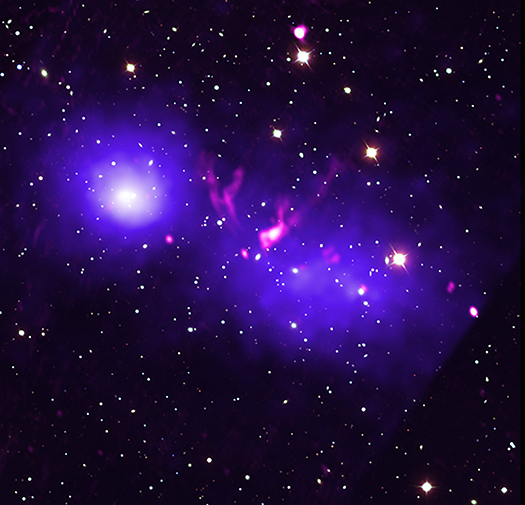For Release: June 25, 2019
RIKEN

Credit: X-ray: NASA/CXC/RIKEN/L. Gu et al; Radio: NCRA/TIFR/GMRT; Optical: SDSS
Press Image, Caption, and Videos
For the first time, astronomers have found two giant clusters of galaxies that are just about to collide. This observation can be seen as a missing ‘piece of the puzzle’ in our understanding of the formation of structure in the Universe, sincelarge-scale structures—such as galaxies and clusters of galaxies—are thought to grow by collisions and mergers. The result waspublished in Nature Astronomy on June 24th, 2019 and used data from NASA’s Chandra X-ray Observatory and other X-ray missions.
Clusters of galaxies are the largest known bound objects and consist of hundreds of galaxies that each contain hundreds of billions of stars. Ever since the Big Bang, these objects have been growing by colliding and merging with each other. Due to their large size, with diameters of a few million light years, these collisions can take about a billion years to complete. Eventually the two colliding clusters will have merged into one bigger cluster.
Because the merging process takes much longer than a human lifetime, we only see snapshots of the various stages of these collisions. The challenge is to find colliding clusters that are just at the stage of first touching each other. In theory, this stage has a relatively short duration and is therefore hard to find. It is like finding a raindrop that just touches the water surface in a photograph of a pond during a rain shower. Obviously, such a picture would show a lot of falling droplets and ripples on the water surface, but only few droplets in the process of merging with the pond. Similarly, astronomers found a lot of single clusters and merged clusters with outgoing ripples indicating a past collision, but until now no two clusters that are just about to touch each other.
An international team of astronomershave now announcedthe discovery of two clusters onthe verge of colliding. This enabledastronomers to test their computer simulations, which show that in the first moments a shock wave, analogous to the sonic boom produced by supersonic motion of an airplane, is created in between the clusters and travels out perpendicular to the merging axis. “These clusters show the first clear evidence for this type of merger shock,” says first author Liyi Gu from RIKEN national science institute in Japanand SRON Netherlands Institute for Space Research. “The shock created a hot belt region of 100-million-degree gas between the clusters, which is expected to extend up to, or even go beyond the boundary of the giant clusters. Therefore, the observed shock has a huge impact on the evolution of galaxy clusters and large scale structures.”
Astronomers are planning to collect more ‘snapshots’ to ultimately build up a continuous model describing the evolution of cluster mergers. SRON-researcher Hiroki Akamatsu: “More merger clusters like this one will be found by eROSITA, an X-ray all-sky survey mission that will be launched this year. Two other upcoming X-ray missions, XRISM and Athena, will help us understand the role of these colossal merger shocks in the structure formation history.”
Liyi Gu and his collaborators studied the colliding pair during an observation campaign, carried out with three X-ray satellites (ESA’s XMM-Newton satellite, NASA’s Chandra, and JAXA’s Suzaku satellite) and two radio telescopes (the Low-Frequency Array, a European project led by the Netherlands, and the Giant Metrewave Radio Telescope operated by National Centre for Radio Astrophysics of India).
Other materials about the findings are available at:
http://chandra.si.edu
For more Chandra images, multimedia and related materials, visit:
http://www.nasa.gov/chandra
Media contacts:
Megan Watzke
Chandra X-ray Center, Cambridge, Mass.
617-496-7998
mwatzke@cfa.harvard.edu


